2016 NISSAN TITAN fuel filter
[x] Cancel search: fuel filterPage 507 of 636
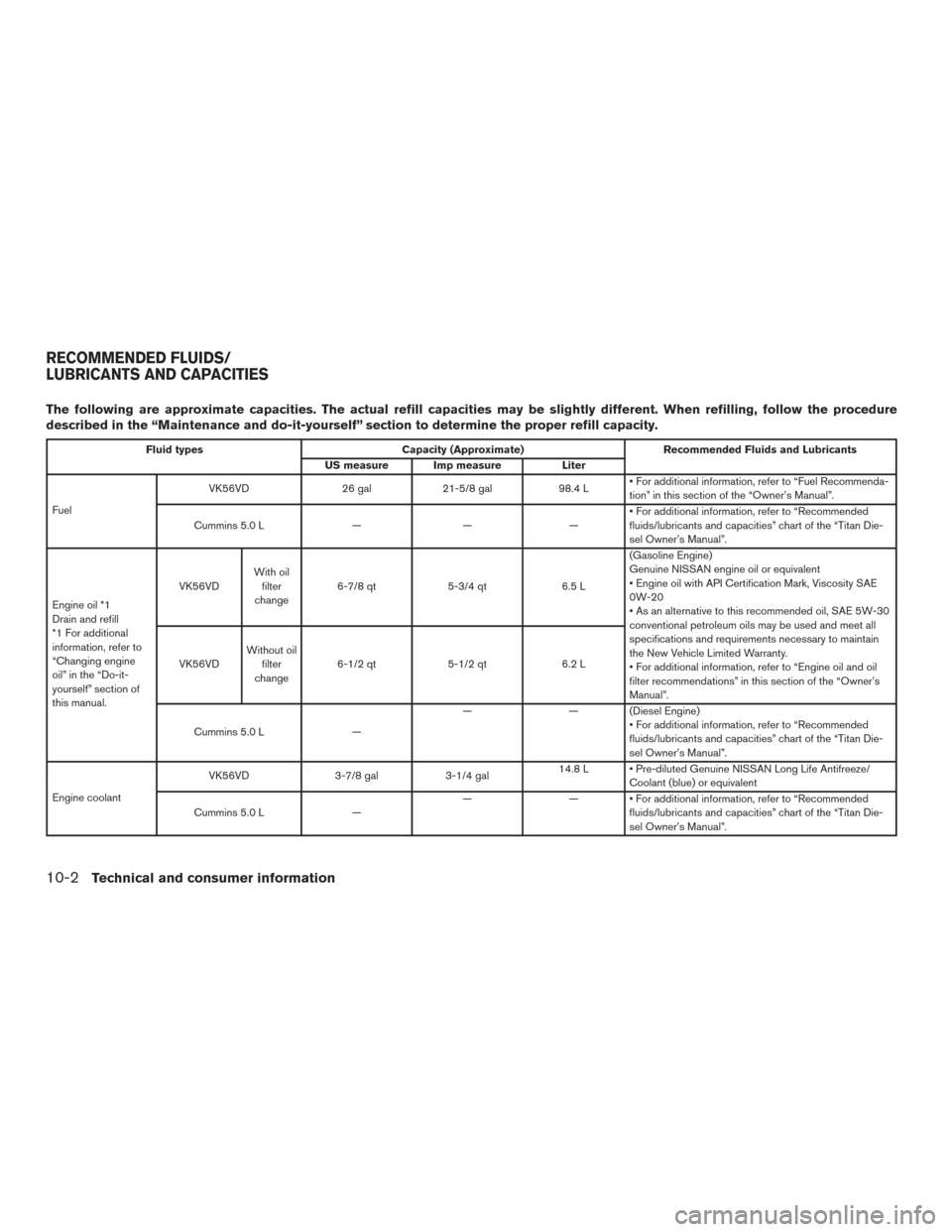
The following are approximate capacities. The actual refill capacities may be slightly different. When refilling, follow the procedure
described in the “Maintenance and do-it-yourself” section to determine the proper refill capacity.
Fluid typesCapacity (Approximate) Recommended Fluids and Lubricants
US measure Imp measure Liter
Fuel VK56VD
26 gal21-5/8 gal 98.4 L• For additional information, refer to “Fuel Recommenda-
tion” in this section of the “Owner’s Manual”.
Cummins 5.0 L ———• For additional information, refer to “Recommended
fluids/lubricants and capacities” chart of the “Titan Die-
sel Owner’s Manual”.
Engine oil *1
Drain and refill
*1 For additional
information, refer to
“Changing engine
oil” in the “Do-it-
yourself” section of
this manual. VK56VD
With oil
filter
change 6-7/8 qt
5-3/4 qt 6.5 L(Gasoline Engine)
Genuine NISSAN engine oil or equivalent
• Engine oil with API Certification Mark, Viscosity SAE
0W-20
• As an alternative to this recommended oil, SAE 5W-30
conventional petroleum oils may be used and meet all
specifications and requirements necessary to maintain
the New Vehicle Limited Warranty.
• For additional information, refer to “Engine oil and oil
filter recommendations” in this section of the “Owner’s
Manual”.
VK56VD
Without oil
filter
change 6-1/2 qt
5-1/2 qt 6.2 L
Cummins 5.0 L ——
— (Diesel Engine)
• For additional information, refer to “Recommended
fluids/lubricants and capacities” chart of the “Titan Die-
sel Owner’s Manual”.
Engine coolant VK56VD
3-7/8 gal3-1/4 gal 14.8 L • Pre-diluted Genuine NISSAN Long Life Antifreeze/
Coolant (blue) or equivalent
Cummins 5.0 L ——
— • For additional information, refer to “Recommended
fluids/lubricants and capacities” chart of the “Titan Die-
sel Owner’s Manual”.
RECOMMENDED FLUIDS/
LUBRICANTS AND CAPACITIES
10-2Technical and consumer information
Page 512 of 636
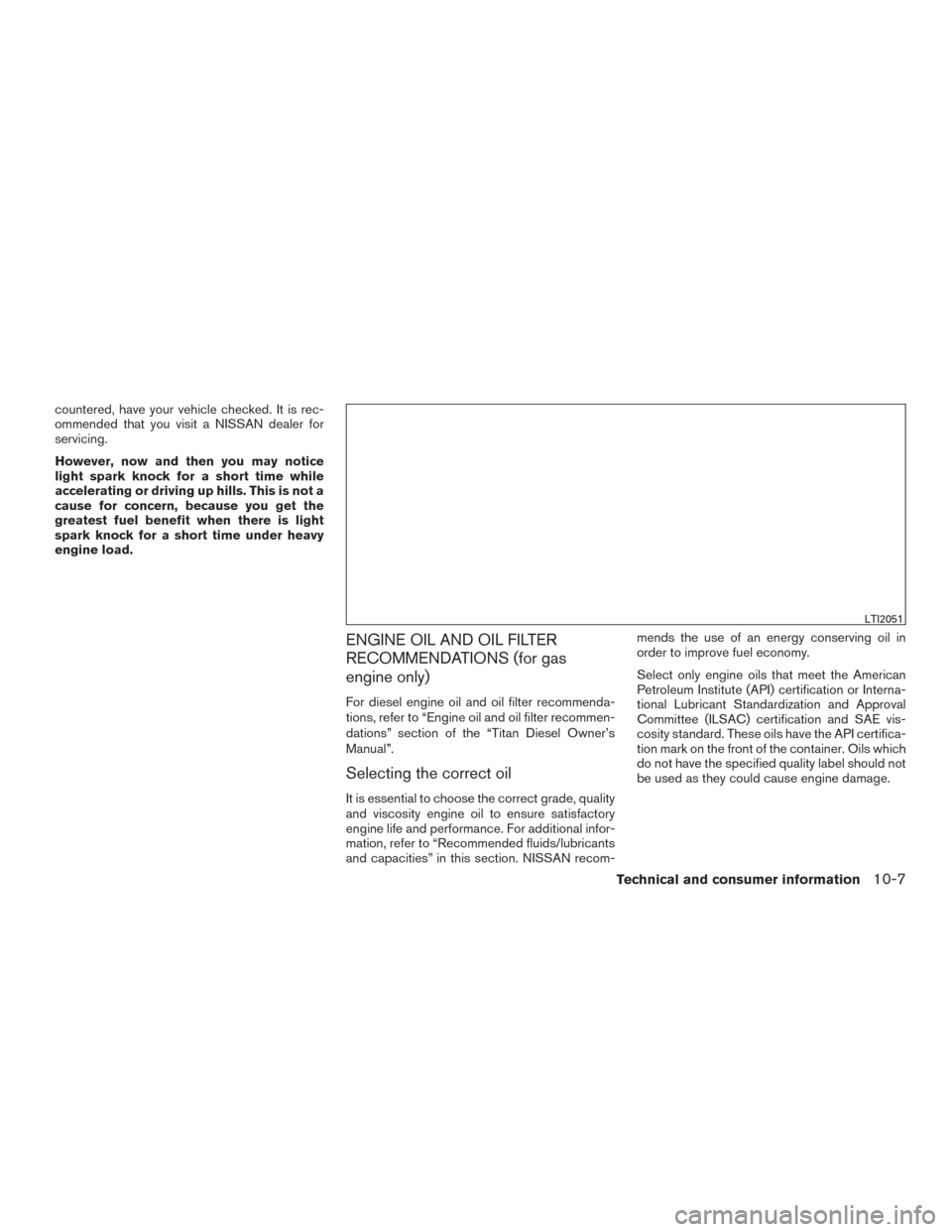
countered, have your vehicle checked. It is rec-
ommended that you visit a NISSAN dealer for
servicing.
However, now and then you may notice
light spark knock for a short time while
accelerating or driving up hills. This is not a
cause for concern, because you get the
greatest fuel benefit when there is light
spark knock for a short time under heavy
engine load.
ENGINE OIL AND OIL FILTER
RECOMMENDATIONS (for gas
engine only)
For diesel engine oil and oil filter recommenda-
tions, refer to “Engine oil and oil filter recommen-
dations” section of the “Titan Diesel Owner’s
Manual”.
Selecting the correct oil
It is essential to choose the correct grade, quality
and viscosity engine oil to ensure satisfactory
engine life and performance. For additional infor-
mation, refer to “Recommended fluids/lubricants
and capacities” in this section. NISSAN recom-mends the use of an energy conserving oil in
order to improve fuel economy.
Select only engine oils that meet the American
Petroleum Institute (API) certification or Interna-
tional Lubricant Standardization and Approval
Committee (ILSAC) certification and SAE vis-
cosity standard. These oils have the API certifica-
tion mark on the front of the container. Oils which
do not have the specified quality label should not
be used as they could cause engine damage.
LTI2051
Technical and consumer information10-7
Page 563 of 636
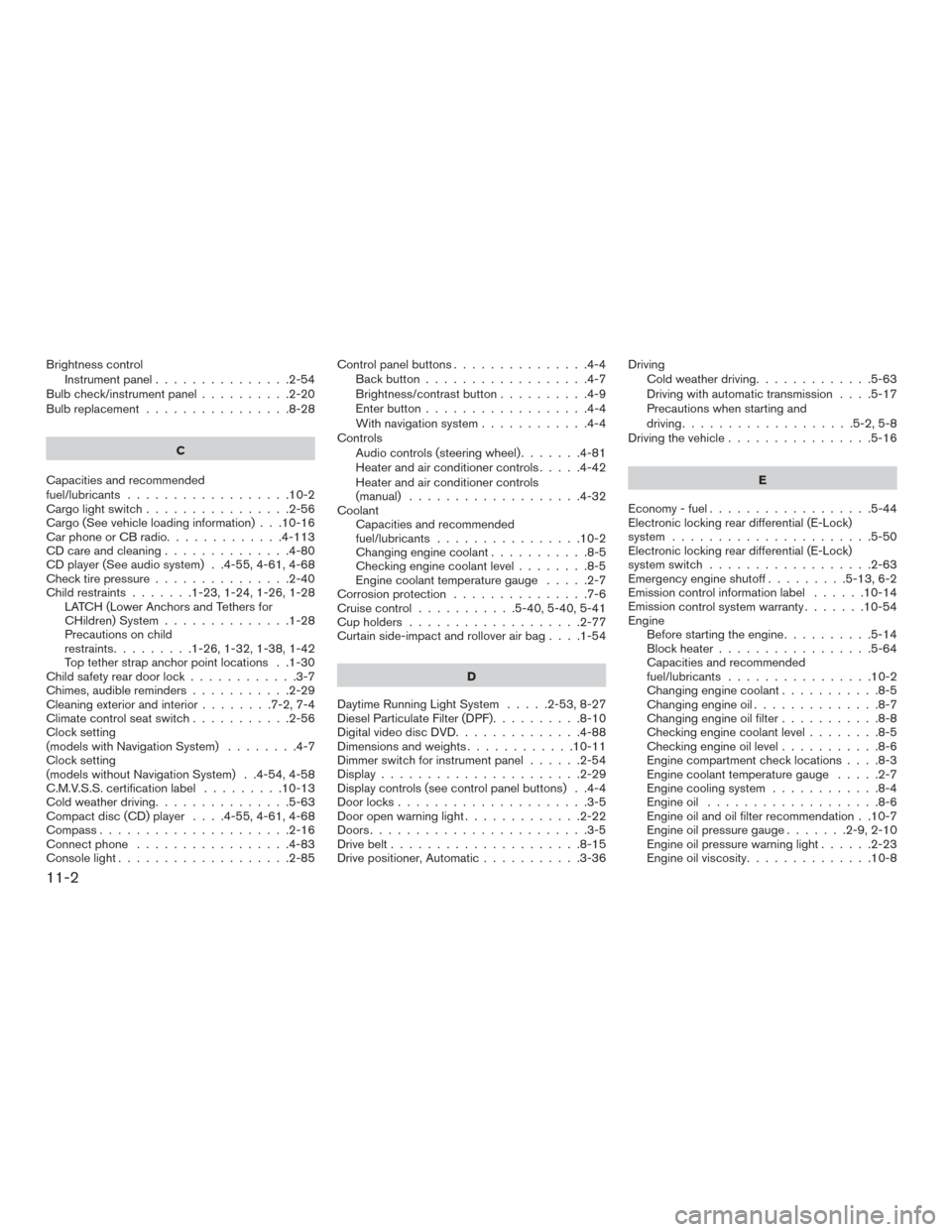
Brightness controlInstrument panel ...............2-54
Bulb check/instrument panel ..........2-20
Bulb replacement ................8-28
C
Capacities and recommended
fuel/lubricants ..................10-2
Cargolightswitch................2-56
Cargo (See vehicle loading information) . . .10-16
Car phone or CB radio .............4-113
CD care and cleaning ..............4-80
CD player (See audio system) . .4-55, 4-61, 4-68
Check tire pressure ...............2-40
Child restraints .......1-23,1-24,1-26,1-28
LATCH (Lower Anchors and Tethers for
CHildren) System ..............1-28
Precautions on child
restraints.........1-26,1-32,1-38,1-42
Top tether strap anchor point locations . .1-30
Child safety rear door lock ............3-7
Chimes, audible reminders ...........2-29
Cleaningexteriorandinterior........7-2,7-4
Climatecontrolseatswitch...........2-56
Clock setting
(models with Navigation System) ........4-7
Clock setting
(models without Navigation System) . .4-54, 4-58
C.M.V.S.S. certification label .........10-13
Cold weather driving ...............5-63
Compact disc (CD) player ....4-55,4-61,4-68
Compass .....................2-16
Connect phone .................4-83
Consolelight...................2-85 Control panel buttons
...............4-4
Back button ..................4-7
Brightness/contrast button ..........4-9
Enterbutton..................4-4
With navigation system ............4-4
Controls Audio controls (steering wheel) .......4-81
Heater and air conditioner controls .....4-42
Heater and air conditioner controls
(manual) ...................4-32
Coolant Capacities and recommended
fuel/lubricants ................10-2
Changingenginecoolant...........8-5
Checking engine coolant level ........8-5
Engine coolant temperature gauge .....2-7
Corrosion protection ...............7-6
Cruisecontrol ...........5-40,5-40,5-41
Cupholders...................2-77
Curtainside-impactandrolloverairbag....1-54
D
Daytime Running Light System .....2-53,8-27
Diesel Particulate Filter (DPF) ..........8-10
Digital video disc DVD ..............4-88
Dimensionsandweights............10-11
Dimmer switch for instrument panel ......2-54
Display......................2-29
Display controls (see control panel buttons) . .4-4
Door locks .....................3-5
Door open warning light .............2-22
Doors ........................3-5
Drive belt .....................8-15
Drive positioner, Automatic ...........3-36Driving
Cold weather driving .............5-63
Driving with automatic transmission ....5-17
Precautions when starting and
driving ...................5-2,5-8
Driving the vehicle ................5-16
E
Economy-fuel..................5-44
Electronic locking rear differential (E-Lock)
system ......................5-50
Electronic locking rear differential (E-Lock)
system switch ..................2-63
Emergency engine shutoff .........5-13,6-2
Emission control information label ......10-14
Emission
control system warranty .......10-54
Engine Before starting the engine ..........5-14
Blockheater.................5-64
Capacities and recommended
fuel/lubricants ................10-2
Changing engine coolant ...........8-5
Changingengineoil..............8-7
Changing engine oil filter ...........8-8
Checking engine coolant level ........8-5
Checking engine oil level ...........8-6
Engine compartment check locations ....8-3
Engine coolant temperature gauge .....2-7
Engine cooling system ............8-4
Engineoil ...................8-6
Engine oil and oil filter recommendation . .10-7
Engineoilpressuregauge.......2-9,2-10
Engine oil pressure warning light ......2-23
Engine oil viscosity ..............10-8
11-2
Page 565 of 636

In-cabin microfilter................8-17
Increasing fuel economy .............5-44
Indicator lights and audible reminders
(See warning/indicator lights and audible
reminders).............2-19,2-20,2-26
Informationdisplay................2-29
Inside automatic anti-glare mirror ....3-27,3-28
Instrument brightness control ..........2-54
Instrument panel ...............0-6,2-2
Instrument panel dimmer switch ........2-54
Intelligent Key system Key operating range ..............3-9
Key operation ................3-10
Mechanicalkey ................3-4
Remote keyless entry operation.......3-13
Troubleshooting guide ............3-18
Warning signals ...............3-18
Interiorlight....................2-84
iPod®Player ...............4-73,4-75
ISOFIX child restraints .............1-28
J
Jump starting ...............6-10,8-14
K
Key.........................3-2
Key fob battery replacement ..........8-23
Keyless entry With Intelligent Key system
(See Intelligent Key system) .........3-13
Keys NISSAN Intelligent Key® ........3-2,3-8 NISSAN Vehicle Immobilizer System keys . .3-4
L
Labels Air conditioner specification label .....10-14
C.M.V.S.S. certification label .......10-13
Emission control information label ....10-14
Engine serial number ............10-13
F.M.V.S.S. certification label ........10-13
Tire and Loading Information label ....10-14
Vehicle identification number (VIN) ....10-12
Vehicle identification number (VIN)
plate.....................10-12
Warning labels (for SRS) ..........1-57
LATCH (Lower Anchors and Tethers for CHildren)
System ......................1-28
License plate Installing the license plate .........10-15
Light Air bag warning light .........1-58,2-26
Brake light (See stop light) .........8-28
Bulb check/instrument panel ........2-20
Bulbreplacement..............8-28
Charge warning light ............2-22
Consolelight.................2-85
Exterior and Interior lights ..........8-28
Foglights...................8-26
Foglightswitch ...............2-55
Headlight and turn signal switch ......2-51
Headlight control switch ..........2-51
Headlights..................8-25
Interiorlight..................2-84
Lightbulbs..................8-25
Low tire pressure warning light .......2-23Low windshield-washer fluid warning
light......................2-41
Personal lights
................2-86
Security indicator light ............2-28
Warning/indicator lights and audible
reminders ............2 -19, 2-20, 2-26
Lights.......................8-25 Maplights ..................2-85
Lock Child safety rear door lock ..........3-7
Door locks ...................3-5
Power door locks ............3-6,3-7
Loose fuel cap warning .............2-43
Low fuel warning light . . .2-23, 2-25, 2-39, 2-40
Low tire pressure warning light .........2-23
Low windshield-washer fluid warning light . . .2-41
Luggage
(See vehicle loading information) . .10-16
M
Maintenance General maintenance .............9-2
Insidethevehicle...............9-3
Maintenance precautions ...........8-2
Outside the vehicle ..............9-2
Seat belt maintenance ............1-23
Under the hood and vehicle .........9-4
Maintenancelog.................9-18
Maintenance requirements ............9-2
Malfunction indicator light ........2-25,2-27
Manual front seat adjustment ...........1-4
Maplights ....................2-85
Mappocket....................2-71
Memory Seat ...................3-36
Meters and gauges .............2-4,2-9
11-4
Page 566 of 636
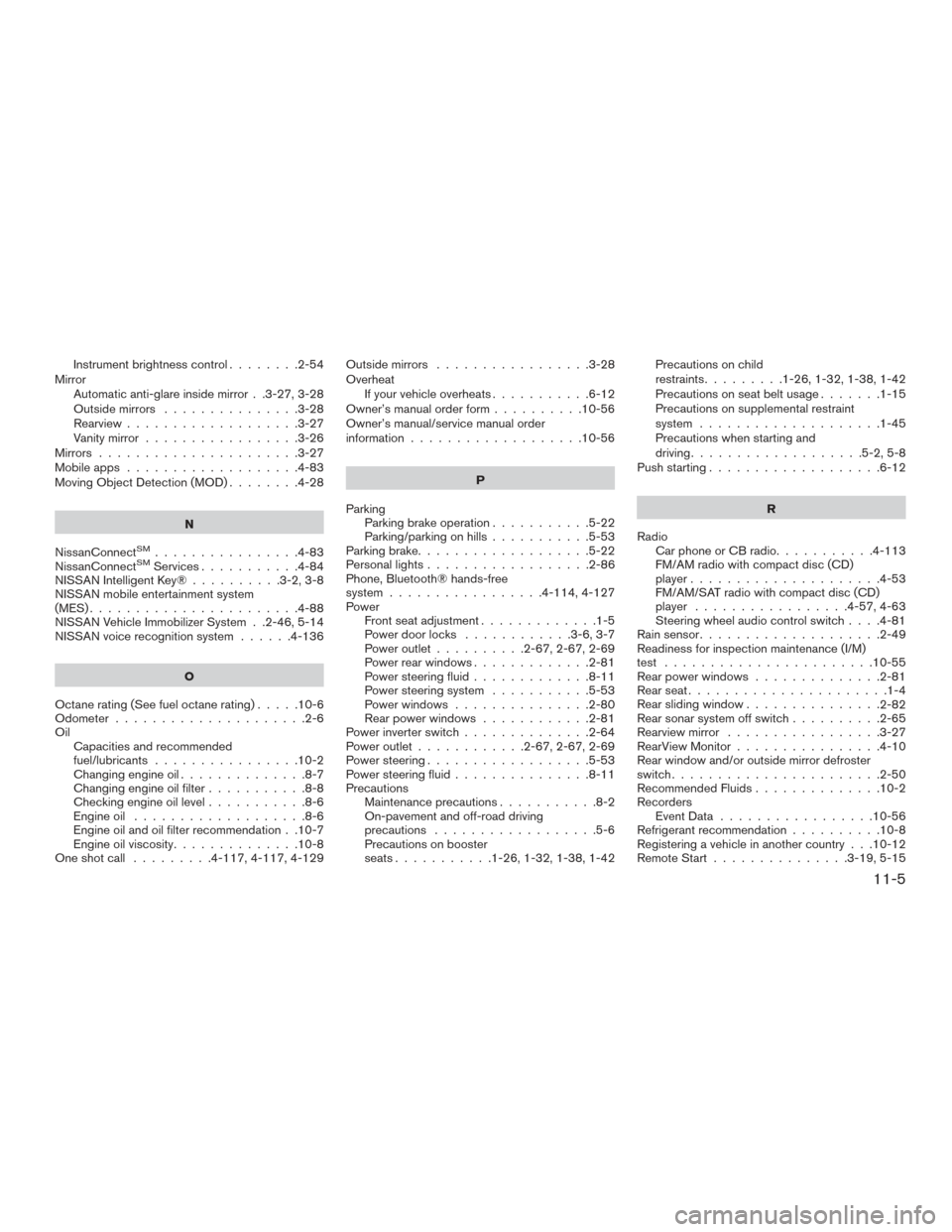
Instrument brightness control........2-54
Mirror Automatic anti-glare inside mirror . .3-27, 3-28
Outside mirrors ...............3-28
Rearview ...................3-27
Vanity mirror .................3-26
Mirrors ......................3-27
Mobileapps ...................4-83
Moving Object Detection (MOD) ........4-28
N
NissanConnect
SM................4-83
NissanConnectSMServices...........4-84
NISSAN Intelligent Key® ..........3-2,3-8
NISSAN mobile entertainment system
(MES) .......................4-88
NISSAN Vehicle Immobilizer System . .2-46, 5-14
NISSAN voice recognition system ......4-136
O
Octanerating(Seefueloctanerating).....10-6
Odometer .....................2-6
Oil Capacities and recommended
fuel/lubricants ................10-2
Changing engine oil ..............8-7
Changing engine oil filter ...........8-8
Checking engine oil level ...........8-6
Engine oil ...................8-6
Engine oil and oil filter recommendation . .10-7
Engine oil viscosity ..............10-8
Oneshotcall .........4- 117, 4-117, 4-129Outside mirrors
.................3-28
Overheat If your vehicle overheats ...........6-12
Owner’s manual order form ..........10-56
Owner’s manual/service manual order
information ...................10-56
P
Parking Parking brake operation ...........5-22
Parking/parking on hills ...........5-53
Parking brake ...................5-22
Personallights..................2-86
Phone, Bluetooth® hands-free
system .................4- 114, 4-127
Power Front seat adjustment .............1-5
Power door locks ............3-6,3-7
Power outlet ..........2-67,2-67,2-69
Power rear windows .............2-81
Power steering fluid .............8-11
Power steering system ...........5-53
Power windows ...............2-80
Rear power windows ............2-81
Power inverter switch ..............2-64
Power outlet ............2-67,2-67,2-69
Power steering ..................5-53
Power steering fluid ...............8-11
Precautions Maintenance precautions ...........8-2
On-pavement and off-road driving
precautions ..................5-6
Precautions on booster
seats...........1-26,1-32,1-38,1-42 Precautions on child
restraints
.........1-26,1-32,1-38,1-42
Precautions on seat belt usage .......1-15
Precautions on supplemental restraint
system ....................1-45
Precautions when starting and
driving ...................5-2,5-8
Push starting ...................6-12
R
Radio CarphoneorCBradio...........4-113
FM/AM radio with compact disc (CD)
player .....................4-53
FM/AM/SAT radio with compact disc (CD)
player .................4-57,4-63
Steering wheel audio control switch . . . .4-81
Rainsensor....................2-49
Readiness for inspection maintenance (I/M)
test .......................10-55
Rear power windows ..............2-81
Rearseat......................1-4
Rear sliding window ...............
2-82
Rear sonar system off switch ..........2-65
Rearview mirror .................3-27
RearView Monitor ................4-10
Rear window and/or outside mirror defroster
switch.......................2-50
Recommended Fluids ..............10-2
Recorders EventData .................10-56
Refrigerant recommendation ..........10-8
Registering a vehicle in another country . . .10-12
Remote Start ...............3-19,5-15
11-5
Page 570 of 636
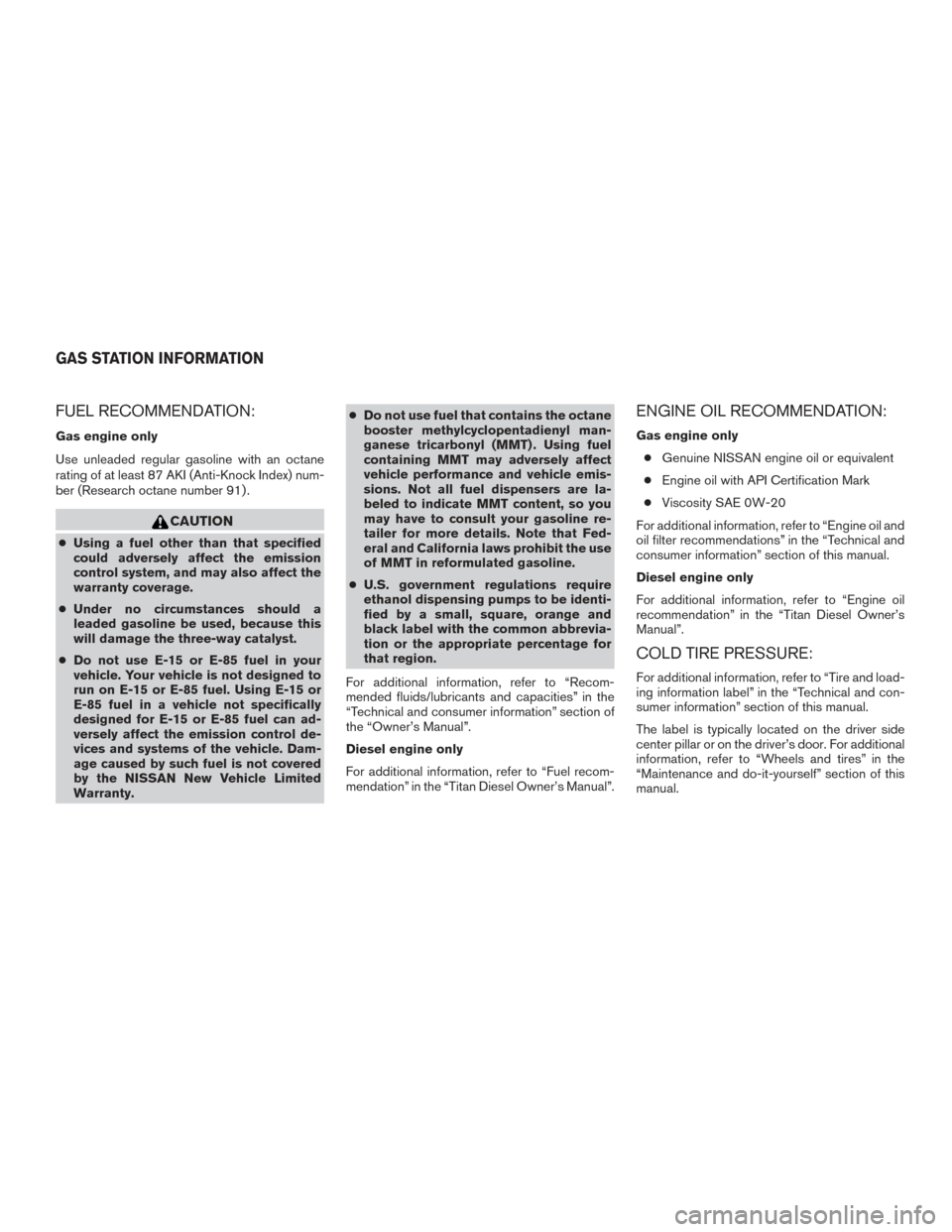
FUEL RECOMMENDATION:
Gas engine only
Use unleaded regular gasoline with an octane
rating of at least 87 AKI (Anti-Knock Index) num-
ber (Research octane number 91) .
CAUTION
●Using a fuel other than that specified
could adversely affect the emission
control system, and may also affect the
warranty coverage.
● Under no circumstances should a
leaded gasoline be used, because this
will damage the three-way catalyst.
● Do not use E-15 or E-85 fuel in your
vehicle. Your vehicle is not designed to
run on E-15 or E-85 fuel. Using E-15 or
E-85 fuel in a vehicle not specifically
designed for E-15 or E-85 fuel can ad-
versely affect the emission control de-
vices and systems of the vehicle. Dam-
age caused by such fuel is not covered
by the NISSAN New Vehicle Limited
Warranty. ●
Do not use fuel that contains the octane
booster methylcyclopentadienyl man-
ganese tricarbonyl (MMT) . Using fuel
containing MMT may adversely affect
vehicle performance and vehicle emis-
sions. Not all fuel dispensers are la-
beled to indicate MMT content, so you
may have to consult your gasoline re-
tailer for more details. Note that Fed-
eral and California laws prohibit the use
of MMT in reformulated gasoline.
● U.S. government regulations require
ethanol dispensing pumps to be identi-
fied by a small, square, orange and
black label with the common abbrevia-
tion or the appropriate percentage for
that region.
For additional information, refer to “Recom-
mended fluids/lubricants and capacities” in the
“Technical and consumer information” section of
the “Owner’s Manual”.
Diesel engine only
For additional information, refer to “Fuel recom-
mendation” in the “Titan Diesel Owner’s Manual”.
ENGINE OIL RECOMMENDATION:
Gas engine only ● Genuine NISSAN engine oil or equivalent
● Engine oil with API Certification Mark
● Viscosity SAE 0W-20
For additional information, refer to “Engine oil and
oil filter recommendations” in the “Technical and
consumer information” section of this manual.
Diesel engine only
For additional information, refer to “Engine oil
recommendation” in the “Titan Diesel Owner’s
Manual”.
COLD TIRE PRESSURE:
For additional information, refer to “Tire and load-
ing information label” in the “Technical and con-
sumer information” section of this manual.
The label is typically located on the driver side
center pillar or on the driver’s door. For additional
information, refer to “Wheels and tires” in the
“Maintenance and do-it-yourself” section of this
manual.
GAS STATION INFORMATION
Page 578 of 636
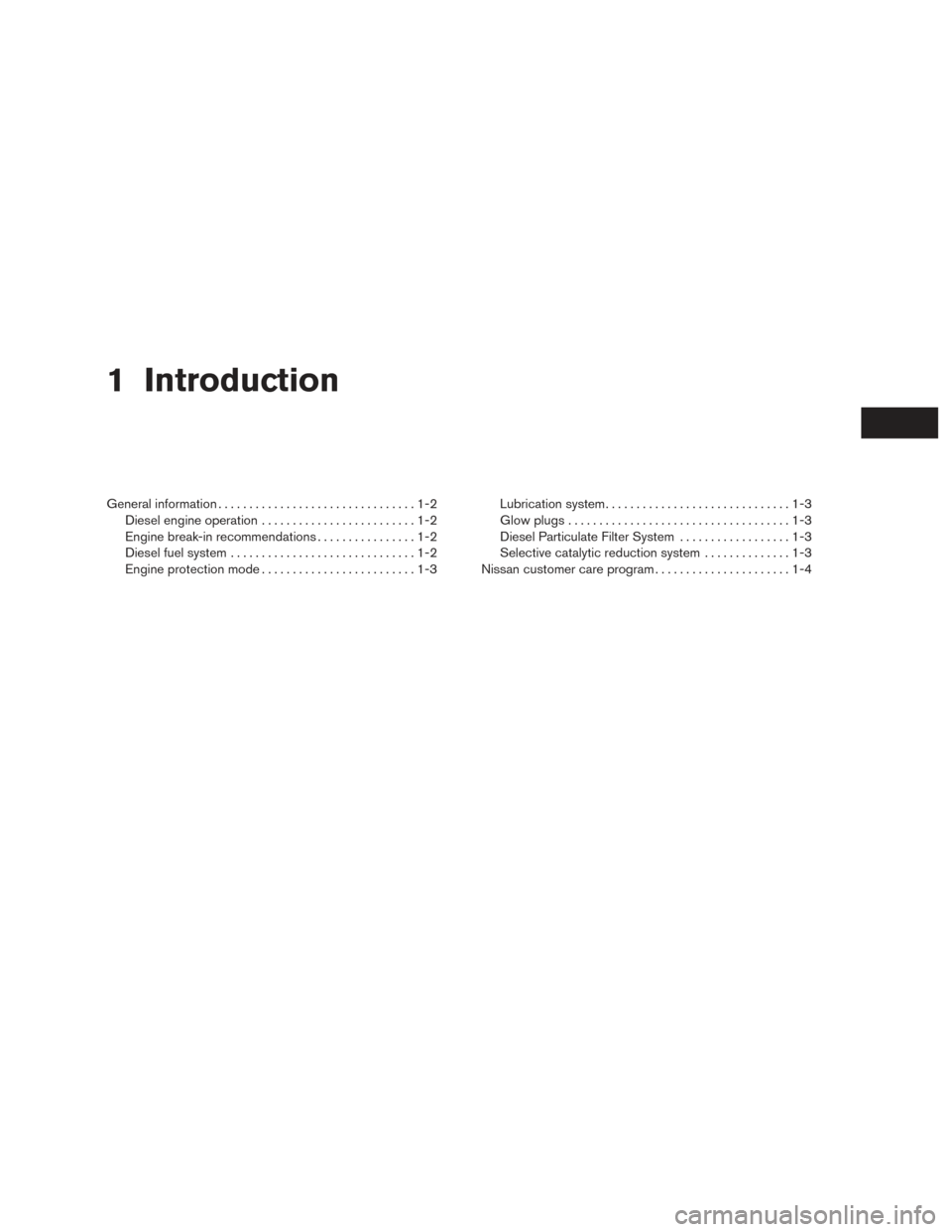
1 Introduction
General information................................1-2
Diesel engine operation .........................1-2
Engine break-in recommendations ................1-2
Diesel fuel system ..............................1-2
Engine protection mode .........................1-3 Lubrication system
..............................1-3
Glow plugs ....................................1-3
Diesel Particulate Filter System ..................1-3
Selective catalytic reduction system ..............1-3
Nissan customer care program . . ....................1-4
Page 579 of 636
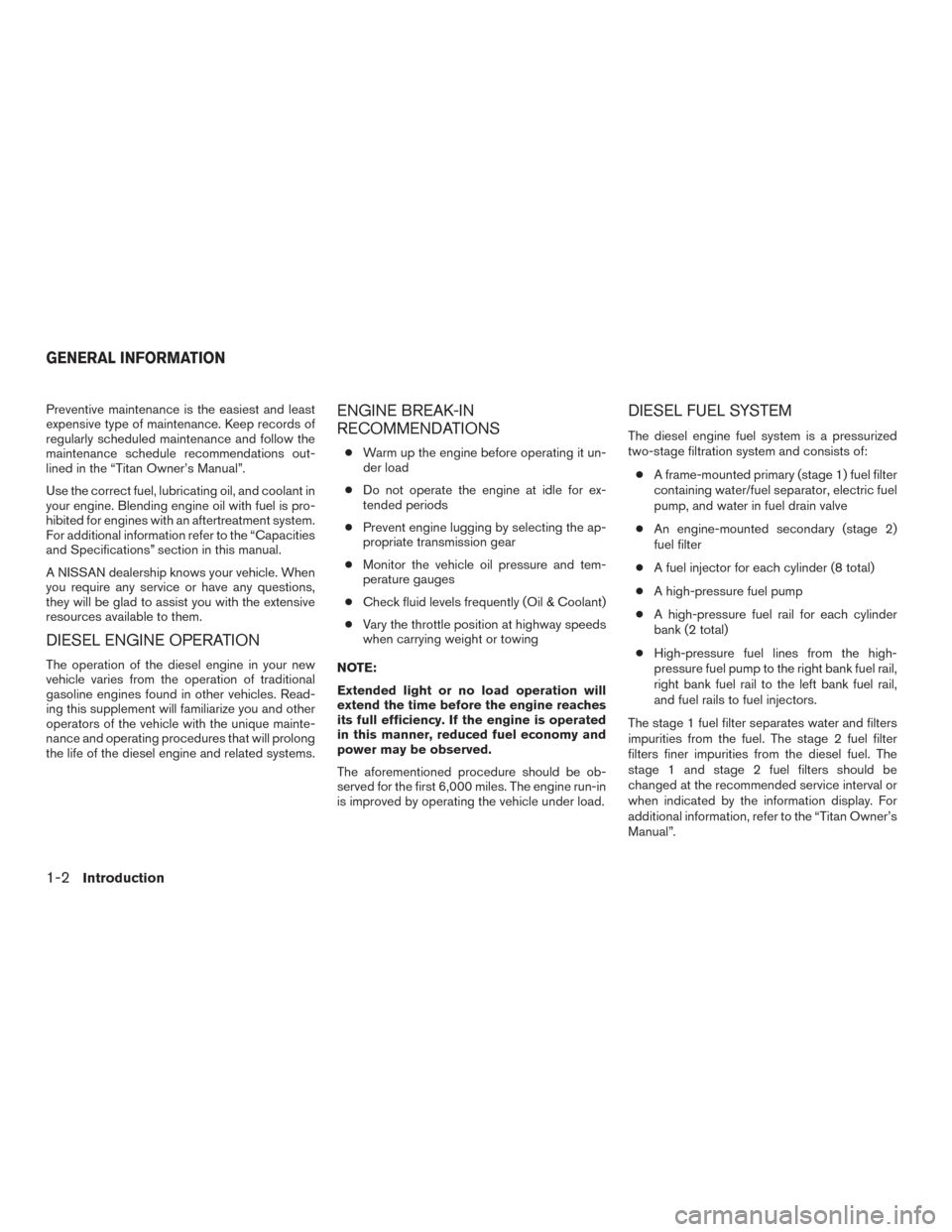
Preventive maintenance is the easiest and least
expensive type of maintenance. Keep records of
regularly scheduled maintenance and follow the
maintenance schedule recommendations out-
lined in the “Titan Owner’s Manual”.
Use the correct fuel, lubricating oil, and coolant in
your engine. Blending engine oil with fuel is pro-
hibited for engines with an aftertreatment system.
For additional information refer to the “Capacities
and Specifications” section in this manual.
A NISSAN dealership knows your vehicle. When
you require any service or have any questions,
they will be glad to assist you with the extensive
resources available to them.
DIESEL ENGINE OPERATION
The operation of the diesel engine in your new
vehicle varies from the operation of traditional
gasoline engines found in other vehicles. Read-
ing this supplement will familiarize you and other
operators of the vehicle with the unique mainte-
nance and operating procedures that will prolong
the life of the diesel engine and related systems.
ENGINE BREAK-IN
RECOMMENDATIONS
●Warm up the engine before operating it un-
der load
● Do not operate the engine at idle for ex-
tended periods
● Prevent engine lugging by selecting the ap-
propriate transmission gear
● Monitor the vehicle oil pressure and tem-
perature gauges
● Check fluid levels frequently (Oil & Coolant)
● Vary the throttle position at highway speeds
when carrying weight or towing
NOTE:
Extended light or no load operation will
extend the time before the engine reaches
its full efficiency. If the engine is operated
in this manner, reduced fuel economy and
power may be observed.
The aforementioned procedure should be ob-
served for the first 6,000 miles. The engine run-in
is improved by operating the vehicle under load.
DIESEL FUEL SYSTEM
The diesel engine fuel system is a pressurized
two-stage filtration system and consists of: ● A frame-mounted primary (stage 1) fuel filter
containing water/fuel separator, electric fuel
pump, and water in fuel drain valve
● An engine-mounted secondary (stage 2)
fuel filter
● A fuel injector for each cylinder (8 total)
● A high-pressure fuel pump
● A high-pressure fuel rail for each cylinder
bank (2 total)
● High-pressure fuel lines from the high-
pressure fuel pump to the right bank fuel rail,
right bank fuel rail to the left bank fuel rail,
and fuel rails to fuel injectors.
The stage 1 fuel filter separates water and filters
impurities from the fuel. The stage 2 fuel filter
filters finer impurities from the diesel fuel. The
stage 1 and stage 2 fuel filters should be
changed at the recommended service interval or
when indicated by the information display. For
additional information, refer to the “Titan Owner’s
Manual”.
GENERAL INFORMATION
1-2Introduction